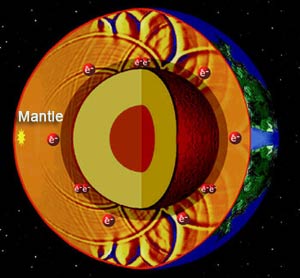The mantle lies between the Earth’s crust and core, extending from depths of 33 km to 2,900 km, accounting for 83.3% of the Earth’s volume. Its position in the middle has also led to it being referred to as the intermediary layer.
 |
|
(Image: aps.anl) |
The mantle is further divided into the upper and lower mantle. The upper mantle consists of silicon, oxygen, iron, and magnesium, with iron and magnesium being the most abundant elements, more so than in the Earth’s crust. This layer is also known as the silicate iron-magnesium mantle, and it is believed that the materials in the mantle are in a locally molten state. It functions like a conveyor belt, facilitating the slow movement of the Earth’s crust and allowing the exchange of materials between the upper and lower layers of the Earth. This layer also serves as the source of magma. The widespread distribution of basaltic rock in the Earth’s crust has been erupted from this magma source.
In the lower mantle, in addition to silicates, the presence of metal oxides and molten materials increases significantly. Its density is greater than that of the upper mantle and exists in a solid state.
Estimates suggest that the temperature of the mantle ranges from 1,000 to 2,000 degrees Celsius, with pressures reaching up to 90 million to 0.382 million atmospheres. The density can reach between 3.3 to 4.6 g/cm3. In such an environment, materials are in a plastic state. Similar to asphalt, the solid state only exists briefly and will deform over time, becoming malleable. The upper mantle, due to lower pressure, contains materials in a partially molten state, referred to as the “plastic layer.” The solid crust floats atop this plastic layer. If any section of the crust has a crack, molten magma will erupt through the fissure, resulting in an active volcano.
The mantle is a vast underground world, about which humanity knows very little.


















































